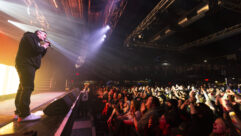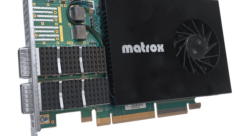
Installation Profile:
Best in Show
Dec 1, 2004 12:00 PM,
By Judith Sagami
The best installs of 2004.
What separates a cutting-edge AV installation from a run-of-the-mill project? Surely, it’s not just about the latest and greatest gear (though the coolest new plasma display or powered loudspeaker can be intoxicating stuff). What makes an installation stand above a host of very compelling projects varies, but perhaps the most interesting element is when systems designers and integrators use gear in creative and innovative ways to overcome a client’s potentially vexing problem.
WordSpring Discovery Center’s gallery of sculptures. Photo: Wordspring Discovery Center.
So, is it a question of squeezing a wide variety of audio and video sources into a small space without letting chaos take over? Sure. It can also be an issue of keeping an eye on the future needs, so that the project can expand as the client’s requirements and the technology change with time. In other cases, it can be the creative (and budget-minded) merging of brand new products and vital legacy gear into an effective system. Or perhaps it’s all about control: routing and corralling disparate sources of audio, video, and data to create a system that gets the job done with a minimum of fuss.
That said, Sound & Video Contractor covered more than a dozen excellent projects in 2004, a mere glimpse at the huge variety of great installations designed, planned, and completed by the best professionals of the industry. As the year winds to a close, the editors have chosen five interesting installations covered in the magazine in the past 12 months. It’s been anything but an easy task. Take a look.
WORDSPRING DISCOVERY CENTER
From its painstaking focus on isolating sound and providing a complete multimedia experience, Wycliffe Bible Translators’ WordSpring Discovery Center in Orlando, Fla., redefines what visitor centers are all about. At 5,000 square feet, WordSpring gives visitors an in-depth look at Wycliffe’s efforts to translate the New Testament into almost 3,000 languages. Accordingly, the system — designed by Wycliffe, Lorenc and Yoo Design, and the Platt Design Group and fabricated by 1220 Exhibits — needed to convey the passion and enormous amount of effort required to complete this task of faith.
Faced with limited space and a host of audio sources, the designers had to overcome possible conflicting acoustic sources to achieve isolation. Considering that the center had a significant number of spoken word sources — including sculpted figures that play back Bible verse recordings in different languages — keeping the space from turning into a cacophonous mess was an important priority.
“Good isolation was crucial in making the space focusable and was necessary to keep visitors from getting distracted by nearby exhibits,” says Jan Lorenc, design director.
Due to space considerations, the designers assigned one SoundTube FP633 parabolic dome for every two figures. An AMX Netlinx system, which has an NXI integrated controller and several hubs, ensures that only one sculpture can play back at a time for a given speaker. The NetLinx system also controls WordSpring’s video and audio components. It uses MIDI to interface with the audio playback system and DMX for the lighting dimmer rack. Located in a central equipment room, the system includes a Web-based interface that allows an attendant at the front desk to control almost everything.
Yet perhaps the most striking design element is the large glass sculpture of a book set on a rock, which has biblical text projected from a space below. Sandblasted to provide the proper texture for a clear image, the book’s surface has text projected from a Mitsubishi X409U digital projector. Source material comes from a Pioneer V7400 industrial DVD player placed below the book in a special recessed area, and visitors who approach the book trigger motion sensors in the lobby, which activate the display. The accompanying background audio comes from a Richmond Sound Design AudioBox AB1616HD through Tannoy i8AW and i5AW speakers.
Video plays a vital role at WordSpring Discovery Center, and that element takes center stage in the circular Townsend Theater. Designed for video, slide presentations, and lectures, the small theater features building materials common to the developing world, including stacked fieldstone and oak-plank benches and walls. The theater’s Mitsubishi XL30U projector is connected to a Pioneer DVD-V7400 DVD player and a VHS machine, and it provides an auxiliary input for other sources (such as laptop computers). A Meyer Sound 5.1 surround system — five UPM-1Ps and a UMS-1P subwoofer — handles audio playback, and a B&K Components 5.1 theater surround processor takes care of surround channels and bass management.
But the remarkable center doesn’t stop with the delicate balance between video and sound. WordSpring also combines light and sound to illustrate the spiritual power of the New Testament. Controls for the dramatic Life Without the Bible exhibit includes a Colortran i48e DMX dimmer rack and a Leprecon LP-1524 programmable console.
When guests move on from the exhibit, they enter an area with interactive displays (Samsung 15in. LCD screens) that teaches about the history of the Bible. Next, visitors can stop at a large tree that features leaves with names of about half the world’s languages. Beneath this tree stand several computer consoles — complete with Avocent LongView Companion keyboards and monitor extenders — that let viewers type in their name in 12 different alphabets.
Finally, a 50in. Samsung PPM50HT plasma display showing an inhouse video awaits visitors at the end of their journey. Visitors who are saddened that their journey is over can take solace in the knowledge that Wycliffe Bible Translators will continue its work.

One of 18 “Gumbies” located thoughout the Hilton Americas Houston. Photo: Thaddeus Leopoulos.
HILTON AMERICAS HOUSTON
While the WordSpring Discovery Center wrestled with the problems borne of ample content in a tight physical space, the designers of the Hilton Americas Houston hotel had a different task at hand: How does a new hotel prepare for future connectivity needs in a manner that is both cost-effective and performance friendly?
Simple. HFP Acoustical Consultants chose to give the hotel, which opened in December 2003, a fiber-optic backbone. At 1,200 rooms, the Hilton Americas Houston may not rival its larger cousins, and it may not share their immediate financial need to use fiber-optic rather than copper wire. Instead, the consultants, led by principal engineer Bill Schuermann, saw savings over time and the inherent flexibility of fiber optics as its main selling points.

Hilton Americas Houston. Photo: Bill Schuermann.
The $385 million hotel houses 93,500 square feet of meeting space. It was up to Oklahoma City’s Ford Audio-Video to serve as the facility’s primary AV systems contractor. Gary Lambert took on the role of onsite supervisor, and Gary Ewald, based in the company’s Austin, Texas office, served as project engineer.
The goal was to make the hotel friendly for broadcast production by providing street access, more rigging points, spotlight/camera rooms above the main ballroom, undercarpet troughs in the ballrooms for camera cables and audio snakes, and AC circuits for production lighting and audio. It was no coincidence that the hotel was the NFL’s official host hotel for the Super Bowl in February 2004.
The fiber-optic network, which is constructed with Sumitomo Electric’s FutureFlex blown-fiber system, snakes its way through the first four floors of the hotel, including the lobby, restaurant, bar, ballrooms, and meeting rooms. Almost all video, audio, and data runs over the 150,000ft. of fiber in the network (except for the standalone Clear-Com production intercom). Roughly half of the tubing stands empty, so the hotel can choose to add more fiber or even replace the whole system with higher-capacity strands.
However, Schuermann soon ran into a problem. Unable to find a product that could offer multimode connectivity and the ability to connect directly to a fiber network, he turned to Broadata Communications, which developed the HFP-1000 (later renamed as the Concierge Fiberstation), an integrated, card cage-based unit that comes in two versions: a standard six-gang floorbox and another designed for a 3RU rackmount. The hotel uses almost 300 of the units, mostly for the ballrooms and meeting areas.
The hotel’s system isn’t simply about fiber-optic cable. Guests enjoy sparkling video from the moment they enter the lobby, courtesy of two Fujitsu 50in. plasma displays. Seven more of the displays can be found throughout the hotel. In addition, 18 NEC plasma displays (the 42in. units are mounted in asymmetrical housings nicknamed “Gumbies” due to their similarity to the cartoon character) are placed at key hallway intersections to provide guests with pertinent information.
Most of the audio, projection screen, video, and room lighting conditions are controlled through a Creston touch-screen system linked via Cresnet to a central computer system. Digital signal processing of audio is handled by 67 BSS Soundweb controllers and routed to Meyer Sound and JBL loudspeakers throughout the public spaces.
Schuermann says it has run well in the year after opening to the public. However, that hasn’t stopped HFP Acoustical Consultants from tweaking it here and there.
“We’re adding back in a lot of displays that were engineered out,” Schuermann says. “It just chugs right along. It’s one of the most painless installs we’ve done.”

Mariner of the Seas promenade. Photo: Ben Dickmann, Martin Professional.
MARINER OF THE SEAS
Installing AV systems on land can be difficult enough, but working on a seagoing vessel is a different ballgame. For Royal Caribbean Cruises (RCCL), the Mariner of the Seas ship needed a system that not only performed better than previous ships, but one that would also come in under a tighter budget. That’s when TeleDimensions International (TDI), a systems integration firm that specializes in outfitting cruise ships, stepped in.
With an eye toward helping the ship’s small AV staff — five sound and light technicians, three broadcast technicians, seven stage staff, and two stage and production managers — manage their duties more efficiently, TDI approached the project from a standpoint of consistency. Wherever possible, TDI president Rex Stull and CEO Marc Goossens worked with RCCL’s lighting and sound specialist, Christopher Vlassopulos, to meet the guidelines for performance and cost efficiency.

The Savoy Theater on the Mariner of the Seas cruise ship. Photo: Ben Dickmann, Martin Professional.
That critical eye extended to the four-deck-high Royal Promenade, with its restaurants, shops, street carnivals, and performers. Sixteen hidden custom Clair Brothers loudspeakers provide sound along the promenade, and Bose 102 loudspeakers provide background music for the main dining room. Background music for the themed restaurants is controlled through a Peavey MediaMatrix X-Frame 88, which is located at a central rack.
The 1,359-seat Savoy Theater features a show control system, videowalls, and a sound system consisting of 66 EAW loudspeakers powered by 35 QSC Audio CX series amplifiers. (The ship sticks with QSC amplifiers throughout for ease of use and built-in redundancy.) TDI installed an analog Crest V12, which ended up working well in the venue as well as helping to keep the project within the budget restrictions.
The theater’s videowalls are constructed with Clarity Tigress 52in. DLP cubes in a 2×2 configuration on either side of the proscenium. The full production booth can source from video servers, videotape, DVD, and cameras.
The Savoy is not the only theater on the ship. Studio B serves as an ice rink and a theater, a dual task requiring a flexible AV system. Complete with a 4×4 cube videowall, multiple TV and LCD screens, LED signs, and cameras, the venue also includes a video production booth. TDI chose a QSControl monitor and remote-control feature, which includes a custom control application. Like the Savoy, Studio B uses EAW loudspeakers and subwoofers.
For guests who want something more than a show, the Dragon’s Lair nightclub evokes a Gothic castle lit by Martin products, including a LightJockey computer and a 2532 Direct Access in the DJ area. Careful engineering, such as a foot of insulation between the floor and the steel structure beneath the club, helps keep the thumping bass from disturbing those outside of the club.
Although the Mariner of the Seas caters to those looking for a relaxing and fun vacation at sea, the ship also boasts full conference systems. From AMX control systems and flat panels to architectural lighting controls and video projection, the facilities can host up to 1,000 people. Video can be routed via an Extron Crosspoint 1616HV RGBHV matrix switcher, and Panasonic cameras, Draper ceiling lifts, and Da-Lite 60”×80” Cosmopolitan Electrol screens round out the experience. The AMX system that controls the conferencing facilities includes five AXD-CV10 color videowall touch panels, a 10.4in. AXM-CA10 color active rackmount touch panel, and an AXT-CA10 tilting tabletop console.
“The entire AV infrastructure has proven to be extremely versatile and robust, and it has stood up to 24/7 operation at sea just as it was designed it to,” Vlassopulos says. He has to deal with any headaches the system may present (invariably at sea), and says the Mariner of the Seas project has worked so well that RCCL has turned to TDI for two larger ships due in 2006 and 2007.

The Zone in the Fed Ex Institute of Technology at the University of Memphis incorporates an LCD screen, a keypad, and two-way audio.
FEDEX INSTITUTE OF TECHNOLOGY
Located at the University of Memphis, the FedEx Institute of Technology could qualify as a system integrator’s dream job. At 95,000 square feet, the $23-million facility has everything from a wireless fidelity network to interactive multimedia theaters for meetings and presentations. Designed as a place for businesses and researchers to collaborate on real-world issues, the facility’s IT tools are helping train the workforce of the future.
That task could only be realized with a top-notch AV system in place. For systems designer Wrightson, Johnson, Haddon, and Williams (WJHW) and integrator Southern Business Communications, the first hurdle was ensuring that the Institute’s multimedia amphitheater, The Zone, could support advanced interactive functionality. But that meant getting the Bosch Digital Congress Network (DCN) and the Creston RACK2 Dual Bus Control systems to talk to each other.
With 190 seats focused on 9.5’×17′, 16:9 rear-projection screen behind the main lectern, the raked-seating arena has gooseneck mics at each workstation that are part of the Bosch DCN, including LCD screens, keypads, and two-way audio. Although the designers were familiar with the Bosch DCN’s use for voting and discussion, they wanted it to offer greatly expanded database and voting features and integration of its camera control ability with the Creston multiple-window display capability. With help from Crestron software engineers, WJHW made this dream a reality.
In The Zone, two Crestron CNX DVP4 digital video processors send signals to an NEC Nighthawk projector and two 43in. Pioneer PDP-433CMX true XGA 16:9 plasma screens facing the podium (which sports an Elo touch screen driven by a Creston TPS-TPI). Used as video processors and display controllers, the DVP4s generate a signal that is fed back into the Extron RGBHV switcher and then routed to the projector, plasma screens, and LCD panels.
When a presentation is in full swing, the 16:9 screen depicts a larger image and three smaller images on the right-hand side. The presenter can swap any of the images on the screen. Input sources for the system are from eight computer connections located in the four floorboxes near the lectern. Another computer connection, as well as VCR, DVD, and TV tuner unit, can be found in a Middle Atlantic rack behind the lectern.
The Zone is not all about video. Audio for the amphitheater comes through two columns of seven Bose MA12 modular line array speakers on either side of the rear-projection screen, which produces a focused wedge of sound that covers the width of the venue but is abruptly truncated at the top and bottom of the array.
In order to achieve the required coverage, the system designer knew that the amphitheater needed an array that stood as tall as the seating area. Accordingly, the architect, Looney, Ricks, Kiss Architects and the Crump Firm, included niches in the metal wall panels that allow the arrays to be recessed in the wall. By using BSS Soundweb, the designers created balanced reinforcement between the left-center-right speakers and the Bosch DCN speakers. A center cluster of three Renkus-Heinz TRX121T-9s and a pair of JBL subwoofers, driven by Crown amplifiers, work with a Creston C2N-DAP8 5.1 digital-audio processor and a Polycom EF2280 multichannel automatic mic/matrix mixer with echo and noise canceling ability to round out the audio system.
The result of this system allows presenters the ease of controlling all the video and audio in The Zone, though technophobic speakers can always turn to Mahathi Kondapati, the institute’s technology analyst.
Students and presenters at the institute can also take advantage of a 60-seat surround-sound theater, a cafe complete with a Mitsubishi four-cube media wall and multizone audio system, and an inviting lobby flush with Pioneer plasma screens showing inhouse messaging and news broadcasts. Given the cutting-edge AV system at the FedEx Institute, researchers and students will be making the University of Memphis a hotspot in workforce training for the foreseeable future.

Plasma screens display video, maps, and directories at the Fashion Show Mall in Las Vegas.
FASHION SHOW MALL
When it comes to running a business on the Las Vegas Strip, going for low-key means getting lost in the maelstrom. That’s why the developer of the Fashion Show Mall, the Rouse Company, decided to turn the concept of the mall on its head. To accomplish this feat, the Rouse Company turned to a diverse team that included integrator Ford AV, Vantage Technology Consulting Group, Whiting-Turner Contracting, i2g, Orne and Associates, and Altoon and Porter Architects.

Fashion Show Mall.
From live fashion shows to The Cloud, a huge steel-framed structure outside the building that serves as a projection screen at night, Fashion Show Mall aggressively courts the 35 million visitors that come to Las Vegas each year. For those driving or walking by Fashion Show Mall, The Cloud is an intriguing beacon.
The structure’s main images work in tandem with four moveable Barco 14 mm LED screens, 24 Martin Exterior 600 Color Changers, and six Martin Mac 200 Performance fixtures. In the past few months, the Fashion Show Mall continued to upgrade and modify its equipment. Originally, Pigi projectors illuminated the bottom of the cloud with still photographs and ads. Steve Pospisil, vice president and director of creative content for the Rouse Company, says that’s changed.
“We have redeployed the Pigi projectors to some different areas of The Cloud surface and replaced the primary projection area with Barco R-18 projectors,” he says. “These are double-stacked so there are four Barco R-18s covering that center image area on the cloud now.” Rarely, however, is full-motion video fed through them. Most of the time, these are used for simple animation graphics. Video will be used in the future, but the video projectors have been in place for only a few weeks.
“Brightness and dependability were the primary reasons for the upgrade,” Pospisil says. “The Pigis just required significantly more maintenance than the Barco video projectors. They have lots of mechanical moving, spooling parts and film that can get stuck and hung up. They really need an operator.”
In addition, more ports were added to the Omneon server sending video to the many 7’*#215;13′ Barco Ilite 8 (8 mm) LED screens in the Great Hall, a central open-air atrium. Media control comes courtesy of the DaletPlus System, which handles content playback throughout the mall. The system allows technicians to acquire video, graphic, and sound content and playback in any combination, and elements such as smoke effects, video, and lights can be controlled manually through the DaletPlus Carts application.
The runway stays busy with seven fashion shows a day, Wednesday through Sunday, and that means that the audio must remain reliable and of high quality. The current system employs a set of JBL AE series main speaker clusters on each side of the main stage, with sets of delay speakers above and along the runway and facing off the rear of the main stage. A MediaMatrix system takes care of audio EQ, routing, and level control.
Show control is handled from the balcony above the stage, but the audio-processing gear (Crown amplifiers) can be found on the ground floor. Sound is mixed through a Soundcraft Spirit 324 Live Digital console combined with two Dbx 166A compressors and two Dbx 2331 graphic EQ units.
With so many lighting needs to handle, the Rouse Company chose to handle lighting control wirelessly with a DMX system. Operated through LCD menus, Radio DMX operates in the 2.4GHz band. Well aware that a venue with heavy RF can create technical headaches, the onsite crew took RF coordination very seriously.
For the shoppers who visit Fashion Show Mall, the amount of meticulous planning and costly technology that went into creating such an advanced facility might never cross their minds. But for those working behind the scenes, improving and maintaining the system remains a never-ending task.
A GLIMPSE OF THE FUTURE
As the systems integration industry continues to evolve, there’s one constant: Every systems designer and consultant must focus intently on satisfying the client’s needs. But as these installations show, it’s not enough to simply make a system work. Industry professionals must anticipate future needs, and part of that is designing and installing systems that are flexible and expandable.
From cutting-edge shopping malls to compelling educational facilities, the installations of the future will require a holistic approach — one that takes into account everything from budget constraints to plain old compatibility issues. That approach, combined with a sense of daring and creativity, will spur the industry toward even greater heights.
Judith Sagami
is a freelance writer based in the Bay Area. Thanks to Charles Conte, Linda Seid Frembes, Bruce Borgerson, Tom Dambly, and Bennett Liles for contributing to this article.
For More Information
Altoon and Porter Architects
www.altoonporter.com
AMX Corp.
www.amx.com
Avocent
www.avocent.com
B&K Components
www.bkcomp.com
Barco
www.barco.com
Bosch Security Systems
www.boschsecurity.com
Bose
www.bose.com
Broadata Communications
www.broadatacom.com
BSS Audio
www.bss.co.uk
Clair Brothers
www.clair-audio.com
Clarity Visual Systems
www.clarityvisual.com
Clear-Com
www.clearcom.com
Colortran
www.colortran.com
Crest Audio
www.crestaudio.com
Crestron
www.crestron.com
The Crump Firm
www.crumpfirm.com
Dalet
www.dalet.com
Da-Lite
www.da-lite.com
Draper
www.draperinc.com
EAW
www.eaw.com
Extron
www.extron.com
Ford AV
www.fordav.com
Fujitsu
www.fujitsu.com
HFP Acoustical
www.hfpacoustical.com
JBL
www.jbl.com
Leprecon
www.leprecon.com
Looney, Ricks, Kiss Architects
www.lrk.com
Lorenc and Yoo Design
www.lorencyoodesign.com
Martin Professional
www.martin.com
Meyer Sound
www.meyersound.com
Middle Atlantic Products
www.middleatlantic.com
Mitsubishi Electric US
www.mitsubishielectric.com
NEC
www.nec.com
Omneon
www.omneon.com
Orne and Associates
www.orneassociates.com
Panasonic
www.panasonic.com
Peavey
www.peavey.com
Pigi
www.etc-pigi.com
Pioneer Electronics
www.pioneerelectronics.com
Platt Design Group
www.plattdesign.com
Polycom
www.polycom.com
QSC Audio
www.qscaudio.com
Renkus-Heinz
www.reinkus-heinz.com
Richmond Sound Design
www.show-control.com
Samsung
www.samsung.com
Soundcraft
www.spiritbysoundcraft.com
SoundTube Entertainment
www.soundtube.com
Southern Business Communications
www.sbcg.com
Sumitomo Electric
www.sumitomo.com
TeleDimensions International
www.teledimensions.com
Tannoy
www.tannoy.com
Vantage Technology Consulting Group
www.vantagetcg.com
Whiting-Turner Contracting Co.
www.whiting-turner.com
WJHW
www.wjhw.com










